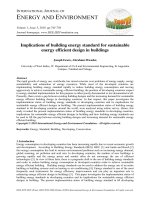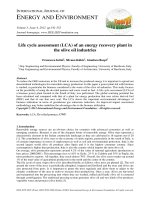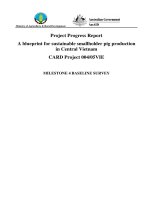Implications of building energy standard for sustainable energy efficient design in buildings
Bạn đang xem bản rút gọn của tài liệu. Xem và tải ngay bản đầy đủ của tài liệu tại đây (237.82 KB, 12 trang )
INTERNATIONAL JOURNAL OF
ENERGY AND ENVIRONMENT
Volume 1, Issue 5, 2010 pp.745-756
Journal homepage: www.IJEE.IEEFoundation.org
Implications of building energy standard for sustainable
energy efficient design in buildings
Joseph Iwaro, Abraham Mwasha
University of West Indies, W. Department of Civil and Environmental Engineering, St.Augustine
Campus, Trinidad and Tobago.
Abstract
The rapid growth of energy use, worldwide, has raised concerns over problems of energy supply, energy
sustainability and exhaustion of energy resources. While most of the developed countries are
implementing building energy standard rapidly to reduce building energy consumption and moving
aggressively to achieve sustainable energy efficient building; the position of developing countries respect
to energy standard implementation for this purpose is either poorly documented or not documented at all.
Presently, there exists a gap between existing building designs and the increasing demand for sustainable
energy efficient building design in developing countries. In that respect, this paper investigates the
implementation status of building energy standards in developing countries and its implications for
sustainable energy efficient designs in building. The present implementation status of building energy
standard in 60 developing countries around the world, were analyzed using online survey. Hence, this
study revealed the present implementation status of building energy standards in developing countries,
implications for sustainable energy efficient designs in building and how building energy standards can
be used to fill the gap between existing building designs and increasing demand for sustainable energy
efficient building.
Copyright © 2010 International Energy and Environment Foundation - All rights reserved.
Keywords: Energy, Standard, Building, Developing, Conservation.
1. Introduction
Energy consumption in developing countries has been increasing rapidly due to recent economic growth
and development. According to Building Energy Standards (BES), HKU [1] and Janda and Busch [2]
this energy consumption has lead to serious environmental problems such as increasing energy demand,
global warming, air pollution and acid rain. In developing countries, the number of new buildings is
growing rapidly and the energy prices and market often do not encourage the use of efficient
technologies [3]. In view of these facts, there is a pragmatic shift to the use of building energy standards
and codes to reduce building energy consumption in developed countries order to achieve sustainable
energy efficient building. Building energy standards can be used to address the energy use of an entire
building or building systems such as heating or air conditioning [4]. Energy standard is one of the most
frequently used instruments for energy efficiency improvements and can play an important role in
enhancing energy efficient design in buildings [5]. This paper investigates the implementation status of
building energy standards in developing countries and its implications for sustainable energy efficient
designs in building. The present implementation status of building energy standard in 60 developing
ISSN 2076-2895 (Print), ISSN 2076-2909 (Online) ©2010 International Energy & Environment Foundation. All rights reserved.
746
International Journal of Energy and Environment (IJEE), Volume 1, Issue 5, 2010, pp.745-756
countries around the world, were analyzed using online survey. Hence, this study revealed the present
implementation status of building energy standards in developing countries, implications for sustainable
energy efficient designs in building and how building energy standards can be used to fill the gap
between existing building designs and increasing demand for sustainable energy efficient design.
2. Buildings standards in developing countries
While building energy efficiency standards exist in almost all developed countries more and more
developing countries are currently introducing such legislation [6, 7]. There are two types of building
energy standards: prescriptive standards that set separate performance levels for major envelope and
equipment components, such as minimum thermal resistance of walls, are used more frequently, possibly
due to their easier enforcement. On the other hand, overall performance-based standards, prescribing
only an annual energy consumption level or energy cost budget, usually provide more incentives for
innovation [8]. However, the effectiveness of building energy standards varies significantly from country
to country, mainly due to difficulties and resulting differences in compliance and enforcement. In
developing countries, building energy standards are often ineffective or much less effective than
predicted [6]. Deringer et al [7] argued that while building energy efficiency standards exist in a number
of developing countries, they are often only on paper due to insufficient implementation and
enforcement, corruption and other problems. Building energy standards in developing countries are
usually promoted by and developed with support from international donor agencies, but if this support
does not cover the implementation period, prospects are rather negative. Building energy standards are a
set of procedures and regulations that prescribe the energy performance of buildings. Energy efficiency
standards can be either mandatory or voluntary. Thomsen et al [9] conducted an international
comparative study of standards for very low energy buildings in the European Union that usefully
describes both governmental and non-governmental activities. Other authors, like Hitchin [10] and
Laussen [11] set their work in an international context, but their goal is to assess the utility of energy
standards as a policy instrument rather than articulating the content in particular countries. The World
Energy Council conducted a survey of 63 countries and found that there were mandatory efficiency
standards for new dwellings and buildings in all European countries [12]. Furthermore, Janda [13]
identified the worldwide status of energy standards for buildings with more focus on developed
countries. Janda conducted a survey of 81 countries and it was found that 61 countries have some form of
mandatory and/or voluntary existing standards, eleven countries had proposed standards, and nine
countries did not have standards. The limited information about developing countries reflects an
information gap surrounding the development, use, and effectiveness of energy standards for building
energy conservation.
3. Methodology
To exploit this important area of research, this paper used mail survey to gather detailed information
about building energy standards. The investigation assessed the progress made so far on the
development, implementation, compliance and usage of building energy standards for energy
conservation in developing countries. The survey was sent to approximately 145 contacts in government,
research organisations and professionals in 95 countries. Given the survey’s length and the need for
specific information in several areas, the response rate of 46% (67 surveys from 46 countries) was better
than anticipated. However, given the importance of this investigation, more contacts were made for more
information. An additional 28 surveys were received from 14 different countries. Hence, a total of 30
surveys were sent to each of the six regions surveyed in this investigation. This was aimed to assess the
region equally even though some regions were more economically developed than the others. The
regions were: Europe, Africa, Asia, North America, Latin America and Middle East. Moreover, World
Bank [14] considers all low- and middle- income countries as developing. Countries with more advanced
economies than other developing nations, but which have not yet fully demonstrated the signs of a
developed country, are grouped under the term newly industrialized countries(NIC).However, IMF uses
a flexible classification system that considers (1) per capita income level, (2) export diversification—so
oil exporters that have high per capita GDP would not make the advanced classification because around
70% of its exports are oil, and (3) degree of integration into the global financial system [15]. In
consideration of the above definitions, this study further classified developing countries as emerging and
developing countries [16] and Graduated developing Countries also known as newly industrialized
countries (NIC). NIC is a category between developed and developing countries [16-20]. The
ISSN 2076-2895 (Print), ISSN 2076-2909 (Online) ©2010 International Energy & Environment Foundation. All rights reserved.
International Journal of Energy and Environment (IJEE), Volume 1, Issue 5, 2010, pp.745-756
747
information from survey respondents’ countries contained: (1) the status of energy standards for
buildings in each country; (2) approaches to standards development (3) implementation. These
investigation variables and the question asked in the survey were derived from literature review [13, 21,
6]. Questions such as status: are there any proposed or existing energy standards for buildings in your
country? What is the status of energy standards for building at national level in your country (mandatory,
mixed/voluntary, proposed and none)? Furthermore, on implementation: What training/educational aids
are used for energy standard implementation in your country? And at what stage in the construction
process is the compliance mechanisms directed (prior, during, after)? .The next section presents the
surveyed data and analysis.
4. Data analysis and discussion
In the sample surveyed, a total of 97 responses were received from 60 different countries. According to
Figure 1, 62% of the countries that responded to this survey were from emerging developing countries
while 38% percent were from graduated/NIC developing countries. The differences in their response can
be attributed to the differences in the level of economic development. Some developing countries have
been classified as "Developed countries" such as South Africa, and Turkey by the CIA [16] and Antigua
and Barbuda, the Bahamas, Bahrain, Barbados, Equatorial Guinea, Kuwait, Oman, Qatar, Trinidad and
Tobago Saudi Arabia by the World Bank [14]. Also newly industrialized countries (NICs) are nations
with economies more advanced and developed than those in the developing world, but not yet with the
full signs of a developed country [16-20]. NIC is a category between developed and developing
countries. It includes Brazil, the People's Republic of China, Malaysia, Mexico, South Africa, Thailand
and Turkey. IMF classified advanced economies as Euro area, major advanced economies(G7), newly
industrialised Asian economies, European Union, and other advanced economies (excluding G7 and euro
area).Also, it classified emerging and developing economies as Africa, Africa- Sub-Sahara, Central and
eastern Europe, Commonwealth of Independent States, Developing Asia, ASEAN-5, Middle East,
Western Hemisphere The above classification by World Bank, IMF and CIA is based on the level of
economic development as they are yet to be recognized as developed countries. Building codes,
standards which address the energy use of an entire building or building systems such as heating or air
conditioning [4], are one of the most frequently used instruments for energy efficiency improvements in
buildings and can play an important role in improving energy efficiency in buildings [5]. While these
building energy standards exist in almost all developed countries more and more developing countries
such as Thailand are currently introducing such legislation [6].
Presently, energy consumption is experiencing an unprecedented growth of 70 percent in emerging
developing countries [22] while energy consumption in other developing regions also grows strongly
over the projection period, with projected increases of around 60 percent for the Middle East and for
Central and South America and 50 percent for Africa. A smaller increase, about 25 percent, is expected
for developing Europe and Eurasia. The energy consumption in developing countries around the world is
increasing with increase in economy, population, GDP and modernisation [23-25]. Likewise, the energy
consumption in newly industrialised developing countries is also increasing with a rapid urbanization
[23, 24, 26]. As such if no building energy conservation actions were carried out as buildings will need
large amount of energy supply for their operations in the following years [23]. Therefore, the
requirements of building energy standards for building energy conservation are considered to be issued
in the form of policy or regulation [27]. As a result of this unique problem confronting developing
countries at different levels of economic development, the effectiveness of building standards varies
significantly from country to country, mainly due to difficulties and resulting differences in economic
development, compliance and enforcement [6]. The building energy standards development and adoption
as investigated in this research showed that 42% of developing countries surveyed have no energy
standard in place, 20% have mandatory, 22% have mixed and 16% proposed. In spites of the fact that,
most developed countries have one kind of building energy standard in place either mandatory, mixed or
being proposed. However, this survey revealed that some developing countries but classified as
developed countries by World Bank [14] such as Trinidad and Tobago and Barbados have no standard in
place.
ISSN 2076-2895 (Print), ISSN 2076-2909 (Online) ©2010 International Energy & Environment Foundation. All rights reserved.
748
International Journal of Energy and Environment (IJEE), Volume 1, Issue 5, 2010, pp.745-756
Figure 1. Respondents’ response rate
Ethiopia
Gabon
Ghana
Grenada
Guinea
Costal Rica
Cameroun
Burundi
Burkina Faso
Nigeria
Guyana
Kenya
Mali
Tanzania
Dominica
Barbados
Togo
Liberia
Ecuador
Cuba
Bangladesh
Trinidad and
Tobago
Angola
St Vincent
Zambia
No Standard
Mexico
Slovak
Rep.
Romania
South
Korea
Slovenia
Czech Rep.
Finland
Portugal
Singapore
Tunisia
Bahrain
Turkey
Kuwait
Poland
Jamaica
Mandatory
Indonesia
South Africa
Thailand
Malaysia
Egypt
Saudi Arabia
Taiwan
Sri Lanka
Palestine
Pakistan
Lebanon
Syria
Belgium
Mixed
Bahamas
Equatorial
Guin.
Antigua and
Barbuda
Omar
Qatar
Paraguay
Algeria
Morocco
Colombia
Brazil
Proposed
Figure 2. Status of Building Energy Standards implementation status in 60 developing countries
(emerging and graduated/NIC), 2010
This position in which 42% of developing countries surveyed have no standard in place could be
attributed to lack of building energy policy, government interest in energy conservation and inadequate
information about the usefulness of building energy standards for building energy efficient design,
building energy consumption, and climate change [28, 7]. Also, it can be a result of corruption, lack of
infrastructure and technology as well as inability of some developing countries to implement efficiency
measures under building energy standard policy due to low level of economy [29, 32, 6]. The major
impediments to implement building energy standards for energy efficiency in the building sector are
institutional barriers and market failures rather than technical problems, as pointed out by Nature
Publishing Group [30]. Among these, Santamouris [31] includes: lack of owners’ awareness of
ISSN 2076-2895 (Print), ISSN 2076-2909 (Online) ©2010 International Energy & Environment Foundation. All rights reserved.
International Journal of Energy and Environment (IJEE), Volume 1, Issue 5, 2010, pp.745-756
749
sustainable design benefits, building energy standards benefits, insufficient awareness and training of
property managers, builders and engineers, lack of specialized professionals to ensure implementation.
Based on the above information, the level of implementation of building energy standards in developing
countries is still far behind when compared to building energy standard in developed countries. In this
study, 25 developing countries out of 60 countries surveyed have no standard compared to Janda [13]
finding where only 9 countries were without standard out of 81 countries surveyed. However, some
levels of progress have been made according to Figure 2, this study recorded new proposals over the
findings from Janda [13]. The countries with proposed standard are: Bahamas, Equatorial Guinea,
Antigua and Barbuda, Omar and Qatar. Also, Syria has mixed/voluntary standard compared to Janda [13]
where Syria only made a proposal for standard. Countries with no building energy standards are far
greater than countries with building energy standards while little proposed standards were recorded. This
shows that the levels of building energy standards implementation in developing countries are still at
infant level when compared to building energy standard implementation in developed countries. The
level of energy reduction recorded is directly linked to their level building energy standard
implementation in developed countries. As confirmed in UNEP [6], building standards in the US are
estimated to have reduced energy use by 15-16% of the baseline in 2000 (0.57 EJ). According to
estimates, new dwellings in the EU built today use on average 60% less energy compared to the building
stock built before the first oil shock. This shows the level of building energy standard development and
adoption in European countries which also confirmed the findings of this study in Figure 2 above, where
most of the euro countries surveyed had mandatory standard in place.
4.1 Overview of regional energy standard implementation performance for developing countries
Building energy standards are starting to appear in the Africa, Latin America and Middle East regions,
even though in general, this is a new development. With UNDP and GEF support, a number of codes are
being developed in developing countries, and these typically include both elemental and integrated routes
to compliance, i. e an elemental method defines the performance requirements of specific building
elements. An integrated method, on the other hand, sets a whole-building performance target and
provides a calculation mechanism for evaluating whether or not a proposed (or actual) building complies
but often only dealing with building envelope issues [21].
Figure 3. Regional energy standard implementation perfor









